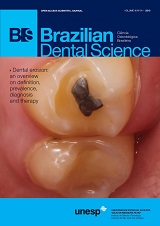Effect of alpha amylase on early childhood caries: a matched case-control study
DOI:
https://doi.org/10.14295/bds.2013.v16i1.873Abstract
Objectives: There are a few studies addressing the relationship between salivary alpha-amylase and dental caries. This study was implemented in order to investigate the effect of salivary alpha-amylase level on early childhood caries (ECC).
Materials and Methods: In this matched case-control study, which was carried out from November 2011 to March 2012 in Hamadan City, the west of Iran, mean levels of salivary alpha-amylase of 84 ECC-active cases were compared to that of 84 ECC-free controls using spectrophotometric method to assay enzyme kinetics. The two groups were matched by oral hygiene (frequency of tooth brushing per day) and food habits (frequency of sugar consumption between servings). Subsequently, a subsample of 28 cases was undergone emergency treatment of dental caries. Alpha amylase level was measured before treatment and 30 to 45 minutes later.
Results: The results indicated an inverse relationship between alpha-amylase level and dental caries. The mean level of salivary alpha-amylase was 28.27 and 42.08 kU/L in cases and controls respectively (P=0.001). In addition, emergency treatment of dental caries increased the level of salivary alpha-amylase significantly from 15.05 kU/L before treatment to 23.94 kU/L thereafter (P=0.001) although the level of alpha-amylase did not reach the normal level of ECC-free controls
Conclusion: Generally it can be concluded that low levels of alpha-amylase may promote early childhood caries. On the other hand, dental caries may subsequently reduce the level of salivary alpha-amylase. This vicious cycle may promote and then accelerate caries formation among susceptible people with low level of salivary alpha-amylase.
Downloads
Downloads
Published
How to Cite
Issue
Section
License
Brazilian Dental Science uses the Creative Commons (CC-BY 4.0) license, thus preserving the integrity of articles in an open access environment. The journal allows the author to retain publishing rights without restrictions.
=================




























